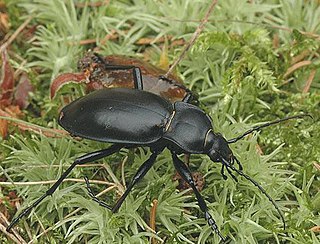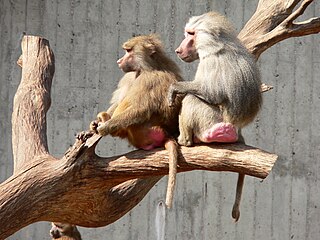
Beetles are insects that form the order Coleoptera, in the superorder Endopterygota. Their front pair of wings are hardened into wing-cases, elytra, distinguishing them from most other insects. The Coleoptera, with about 400,000 described species, is the largest of all orders, constituting almost 40% of described insects and 25% of all known animal species; new species are discovered frequently, with estimates suggesting that there are between 0.9 and 2.1 million total species. Found in almost every habitat except the sea and the polar regions, they interact with their ecosystems in several ways: beetles often feed on plants and fungi, break down animal and plant debris, and eat other invertebrates. Some species are serious agricultural pests, such as the Colorado potato beetle, while others such as Coccinellidae eat aphids, scale insects, thrips, and other plant-sucking insects that damage crops.

Grouse are a group of birds from the order Galliformes, in the family Phasianidae. Grouse are presently assigned to the tribe Tetraonini, a classification supported by mitochondrial DNA sequence studies, and applied by the American Ornithologists' Union, ITIS, International Ornithological Congress, and others. Grouse inhabit temperate and subarctic regions of the Northern Hemisphere, from pine forests to moorland and mountainside, from 83°N to 28°N. Turkeys are closely related to grouse and are also classified in the tribe Tetraonini. The koklass pheasant is also closely allied with them.

Sexual dimorphism is the condition where sexes of the same species exhibit different morphological characteristics, particularly characteristics not directly involved in reproduction. The condition occurs in most animals and some plants. Differences may include secondary sex characteristics, size, weight, color, markings, or behavioral or cognitive traits. Male–male reproductive competition has evolved a diverse array of sexually dimorphic traits. Aggressive utility traits such as “battle” teeth and blunt heads reinforced as battering rams are used as weapons in aggressive interactions between rivals. Passive displays such as ornamental feathering or song-calling have also evolved mainly through sexual selection. These differences may be subtle or exaggerated and may be subjected to sexual selection and natural selection. The opposite of dimorphism is monomorphism, when both biological sexes are phenotypically indistinguishable from each other.

Tiger beetles are a family of beetles, Cicindelidae, known for their aggressive predatory habits and running speed. The fastest known species of tiger beetle, Rivacindela hudsoni, can run at a speed of 9 km/h, or about 125 body lengths per second. As of 2005, about 2,600 species and subspecies were known, with the richest diversity in the Oriental (Indo-Malayan) region, followed by the Neotropics. While historically treated as a subfamily of ground beetles (Carabidae) under the name Cicindelinae, several studies since 2020 indicated that they should be treated as a family, the Cicindelidae, which are a sister group to Carabidae within the Adephaga.

Ceratopsidae is a family of ceratopsian dinosaurs including Triceratops, Centrosaurus, and Styracosaurus. All known species were quadrupedal herbivores from the Upper Cretaceous. All but one species are known from western North America, which formed the island continent of Laramidia during most of the Late Cretaceous. Ceratopsids are characterized by beaks, rows of shearing teeth in the back of the jaw, elaborate nasal horns, and a thin parietal-squamosal shelf that extends back and up into a frill. The group is divided into two subfamilies—Chasmosaurinae and Centrosaurinae. The chasmosaurines are generally characterized by long, triangular frills and well-developed brow horns. The centrosaurines had well-developed nasal horns or nasal bosses, shorter and more rectangular frills, and elaborate spines on the back of the frill.

Flower chafers are a group of scarab beetles, comprising the subfamily Cetoniinae. Many species are diurnal and visit flowers for pollen and nectar, or to browse on the petals. Some species also feed on fruit. The group is also called fruit and flower chafers, flower beetles and flower scarabs. There are around 4,000 species, many of them still undescribed.
Monogamous pairing in animals refers to the natural history of mating systems in which species pair bond to raise offspring. This is associated, usually implicitly, with sexual monogamy.

Madame Berthe's mouse lemur or Berthe's mouse lemur is the smallest of the mouse lemurs and the smallest primate in the world; the average body length is 9.2 cm (3.6 in) and seasonal weight is around 30 g (1.1 oz). Microcebus berthae is one of many species of Malagasy lemurs that came about through extensive speciation, caused by unknown environmental mechanisms and conditions.

The Italian wall lizard or ruin lizard is a species of lizard in the family Lacertidae. P. siculus is native to Bosnia and Herzegovina, Croatia, France, Italy, Serbia, Montenegro, Slovenia, and Switzerland, but has also been introduced to Spain, Turkey, the United States, and Canada. It is the most abundant lizard species in southern Italy.

Carabus is a genus of beetles in family Carabidae. The genus is highly diverse with 94 subgenera, 959 species and 2300 subspecies, thus is the largest genus in the subfamily Carabinae. The vast majority are native to the Palearctic, but 16 Nearctic species are also known. Carabus spp. are 12–50 mm (0.47–1.97 in) long, and most species are wingless and often very colourful. These are nocturnal, predatory beetles that feed on snails, earthworms, and caterpillars. Most Carabus species were thought to have inhabited the Eurasian forest, but the species' low dispersal abilities altered the distribution of lineages within the genus.

Sexual dimorphism describes the morphological, physiological, and behavioral differences between males and females of the same species. Most primates are sexually dimorphic for different biological characteristics, such as body size, canine tooth size, craniofacial structure, skeletal dimensions, pelage color and markings, and vocalization. However, such sex differences are primarily limited to the anthropoid primates; most of the strepsirrhine primates and tarsiers are monomorphic.
Sexual antagonistic co-evolution is the relationship between males and females where sexual morphology changes over time to counteract the opposite's sex traits to achieve the maximum reproductive success. This has been compared to an arms race between sexes. In many cases, male mating behavior is detrimental to the female's fitness. For example, when insects reproduce by means of traumatic insemination, it is very disadvantageous to the female's health. During mating, males will try to inseminate as many females as possible, however, the more times a female's abdomen is punctured, the less likely she is to survive. Females that possess traits to avoid multiple matings will be more likely to survive, resulting in a change in morphology. In males, genitalia is relatively simple and more likely to vary among generations compared to female genitalia. This results in a new trait that females have to avoid in order to survive.

The Chaco tortoise, also known commonly as the Argentine tortoise, the Patagonian tortoise, or the southern wood tortoise, is a species of tortoise in the family Testudinidae. The species is endemic to South America.

Chrysochroinae is a subfamily of beetles in the family Buprestidae: the "jewel beetles".

Ceroglossus is a genus of beetles in the family Carabidae, whose members are restricted to Chile and Argentina. The genus contains the following species:

Ceroglossus buqueti is a beetle of the family Carabidae.

Commerson's roundleaf bat, also known as Commerson's leaf-nosed bat, is a species of bat endemic to Madagascar. It is named after French naturalist Philibert Commerson (1727-1773). Bat populations of Africa or São Tomé and Príncipe formerly considered part of this species are now classified separately as M. gigas, M. thomensis or M. vattatus, while one from Madagascar was split off to become M. cryptovalorona. It was formerly placed in the genus Hipposideros, but moved to the resurrected Macronycteris in 2017 on the basis of molecular evidence.

Dicercini is a tribe of metallic wood-boring beetles in the family Buprestidae. There are more than 30 genera and over 750 described species in Dicercini.

Hemiandrus maculifrons is a species of ground wētā endemic to New Zealand. They are nocturnal, carnivorous, and flightless orthopterans belonging to the family Anostostomatidae. Being a nocturnal species, individuals remain in tunnels in the ground during the day and emerge from their burrows after sunset to forage and hunt for small invertebrates. H. maculifrons is one of the smallest New Zealand weta species, averaging 15 mm in length and weighing 1–3 g. Unlike the tree weta and tusked weta, where sexual dimorphism is found in the form of male weaponry, ground weta only exhibit sexual size dimorphism: the females are larger than the males.

Ampedus is a genus of click beetles in the family Elateridae. There are currently 461 recognized species of Ampedus beetles. It has a cosmopolitan distribution, but is found mostly in the Holarctic region, primarily in North America, Europe, and Asia. The oldest known fossil from this genus was found in Eocene Baltic amber, estimated to be from 38.0–33.9 million years ago.

















